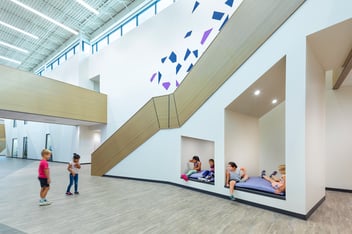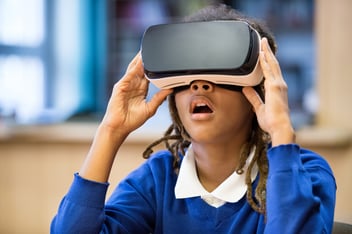
As learning from home becomes a new reality for kids everywhere, long-term implications are being questioned. How can parents and educators make remote learning a happy and meaningful experience? How can we prevent or reduce the chances of this disruption happening again? Let's explore techniques that we can adapt from healthcare designs to help reduce the rate of infection, improve well-being and help school communities stay healthy.
Influencing Behavior
Clearly, public health is affected by the built environment. This is especially true of K12 schools. A school building's impact on students can be both direct and indirect. While human behavior is the ultimate in controlling a pandemic, architecture and design have the power to guide it. The WHO's Outbreak Communications Planning Guide suggests behavioral changes can reduce the spread by as much as 80%! Below are suggestions that can influence desired behaviors:- Acknowledge and rethink day-to-day routines and behaviors of students and staff.
- Offer new places for personal belongings to be stored with the aim of limiting the contact of personal objects with shared areas and surfaces.
- Review and adjust patterns of student movement throughout your school as they relate to shared and frequently used surfaces and areas.
- Contemplate the amount of student movement and how it can be optimized or even reduced.
- Examine the process of cleaning surfaces when students move between stations/areas, as well as the materials of the surfaces themselves.
Leveraging Automation to Decrease Your Touchpoints
New tech is continuing to increase the prevalence of automation in hospitals on a global scale. We love this trend, as it tends to create more efficient, safer healthcare environments – but schools can and should be doing this, too! Schools can include technology that reduces frequently touched surfaces and maintain overall building health. Advances in automated processes, hands-free technology and voice/device-activated solutions include the following:- Computers and sensors that watch temperature, humidity, movement and density.
- Technology that monitors facility equipment and alerts building managers when repairs are needed.
- Devices that facilitate touchless access to regularly used spaces like classrooms and bathrooms
Smart Design Solutions for Safer Schools
Much like healthcare spaces, K12 schools can utilize materials, designs and procedures that mitigate opportunities for the spread of diseases. These include:- Increasing the number and visibility of hand washing stations
- Reducing the number of unnecessary surfaces
- Designing for ease-of-cleaning
- Minimizing the need for surface clutter with smarter storage solutions
- Making way for UVC lights in your designs to kill microorganisms
- Including High Efficiency Particulate Air (HEPA) filtration to remove airborne particles
- Developing more robust cleaning protocols
- Considering how cleaners impact the surfaces of your chosen materials.


